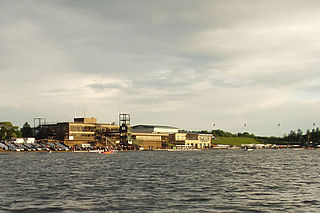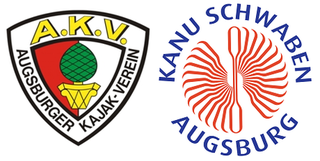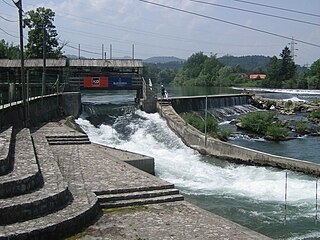
Whitewater kayaking is an adventure sport where a river is navigated in a decked kayak. Whitewater kayaking includes several styles. River running; where the paddler follows a river and paddles rapids as they travel. Creeking usually involving smaller, steeper, and more technical waterways. Creek boats tend to be short but high volume to allow for manoeuvrability while maintaining buoyancy. Slalom requires paddlers to navigate through "gates". Slalom is the only whitewater event to be in the Olympics. Play boating involves staying on one feature of the river and is more artistic than the others. Squirt boating uses low-volume boats to perform special moves in whitewater features.

Canoe slalom is a competitive sport with the aim to navigate a decked canoe or kayak through a course of hanging downstream or upstream gates on river rapids in the fastest time possible. It is one of the two kayak and canoeing disciplines at the Summer Olympics, and is referred to by the International Olympic Committee (IOC) as Canoe/Kayak Slalom. The other Olympic canoeing discipline is canoe sprint. Wildwater canoeing is a non-Olympic paddlesport.

Holme Pierrepont Country Park, home of The National Water Sports Centre is located in the hamlet of Holme Pierrepont near Nottingham, England and on the River Trent. It is used for many different types of sports and has recently received significant investment which has enabled a major refurbishment of existing facilities as well as introduction of new facilities.

The Augsburg Eiskanal is an artificial whitewater river in Augsburg, Germany, constructed as the canoe slalom venue for the 1972 Summer Olympics in nearby Munich.

An artificial whitewater course (AWWC) is a site for whitewater canoeing, whitewater kayaking, whitewater racing, whitewater rafting, playboating and slalom canoeing with artificially generated rapids.

Lee Valley White Water Centre is a white-water slalom centre in the Middle Lea Valley, in the Borough of Broxbourne, Hertfordshire. It was constructed to host the canoe slalom events of the London 2012 Olympic Games.

The Penrith Whitewater Stadium is located near Sydney, Australia. It is an artificial whitewater sporting facility which hosted the canoe/kayak slalom events at the 2000 Summer Olympics in Sydney. The facility is part of the Penrith Lakes Scheme, which is converting open-pit sand and gravel mines into lakes for recreation. It is close to Cranebrook and is adjacent to the Sydney International Regatta Centre. These lakes are not filled via the Nepean River, but are filled via rain water and ground water. The operation of the facility aerates the water and improves water quality in the flat water rowing and canoeing course.

The U.S. National Whitewater Center (USNWC) is a not-for-profit outdoor recreation and athletic training facility for whitewater rafting, kayaking, canoeing, rock climbing, mountain biking, hiking and ice skating which opened to the public in 2006. The Center is located in Charlotte, North Carolina on approximately 1,300 acres (530 ha) of land adjacent to the Catawba River, with more than 50 miles (80 km) of developed trail.

The Kananaskis River is a mountain river in western Alberta, Canada. It is a tributary of the Bow River, crossing the length of Kananaskis Country.

The Shunyi Olympic Rowing-Canoeing Park was built for the rowing, canoeing and 10 km open-water swimming events in the 2008 Summer Olympics. It is located in Mapo Village in the Shunyi District in Beijing.

Cardington Artificial Slalom Course (CASC) was the first artificial whitewater canoe slalom course in the UK when it was completed in July 1982, having been first discussed in 1972.

The Dickerson Whitewater Course, on the Potomac River near Dickerson, Maryland, was built for use by canoe and kayak paddlers training for the 1992 Olympic Games in Spain. It was the first pump-powered artificial whitewater course built in North America, and is still the only one anywhere with heated water. It remains an active training center for whitewater slalom racing, swiftwater rescue training, and other whitewater activities.

Whitewater canoeing is the sport of paddling a canoe on a moving body of water, typically a whitewater river. Whitewater canoeing can range from simple, carefree gently moving water, to demanding, dangerous whitewater. River rapids are graded like ski runs according to the difficulty, danger or severity of the rapid. Whitewater grades range from I or 1 to VI or 6. Grade/Class I can be described as slightly moving water with ripples. Grade/Class VI can be described as severe or almost unrunnable whitewater, such as Niagara Falls.

The Tacen Whitewater Course is a venue for canoe and kayak slalom competition in Tacen, Slovenia, a suburb of Ljubljana. Located on the Sava River, eight kilometers northwest of the city center, it is known locally as Kayak Canoe Club Tacen. The course played an important role in development of the sport during the past six decades. In 1939, when its first competition was held, it was a natural rapid at the base of a dam in the Sava River. In 1990, after many upgrades, it was given a concrete channel and the features of a modern Olympic-style slalom course. The course now starts in the lake behind the dam, and the spillway is the first drop. Tacen hosts a major international competition almost every year, examples being the 1955, the 1991, and the 2010 Championships.

The Ocoee Whitewater Center, near Ducktown, Tennessee, United States, was the canoe slalom venue for the 1996 Summer Olympics in Atlanta, and is the only in-river course to be used for Olympic slalom competition. A 1,640 foot stretch of the Upper Ocoee River was narrowed by two-thirds to create the drops and eddies needed for a slalom course. Today, the course is watered only on summer weekends, 34 days a year, for use by guided rafts and private boaters. When the river has water, 24 commercial rafting companies take more than 750 raft passengers through the course each day.

Kanupark Markkleeberg, built in 2006, is the second of two artificial whitewater canoe/kayak slalom courses in Germany, and the only one powered by pumps. The other German course is the Eiskanal in Augsburg, used in the 1972 Summer Olympic Games in Munich. Kanupark Markkleeberg is located on the southeast shore of Markkleeberger See, a lake south of Markkleeberg, a suburb on the south side of Leipzig. A former open-pit coal mine, the lake was flooded in 1999 with groundwater and developed as a water recreation area. The lake is part of the Leipziger Neuseenland, the largest landscape construction project in Europe, which is reclaiming formerly barren industrial and mining sites for recreational use.

Canoeing – recreational boating activity or paddle sport in which you kneel or sit facing forward in an open or closed-decked canoe, and propel yourself with a single-bladed paddle, under your own power.

The Ondrej Cibak Whitewater Slalom Course, in Liptovský Mikuláš, Slovakia, is the world's second-oldest artificial whitewater venue for international canoe slalom competition, after the Augsburg Eiskanal. Built in 1978, it diverts water around a small dam on the Váh river. With recent upgrades, including a covered stadium for spectators, it remains a prime site for the sport.

The Kraków-Kolna Canoe Slalom Course is an artificial whitewater course in Poland, on the south bank of the Vistula River, in the suburb of Kolna, 10 kilometres (6 mi) west of Kraków. It is fed with river water diverted around a nearby dam. The top 120 metres (394 ft) of the course is a flatwater start pool that is covered in winter by a long white tent. Air inside the tent is heated, but the water is cold.




































